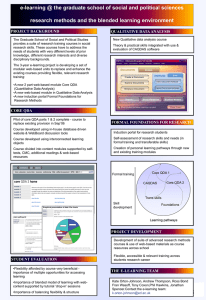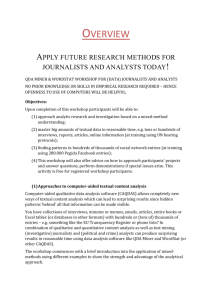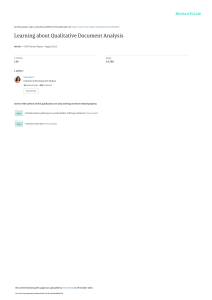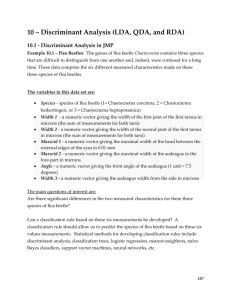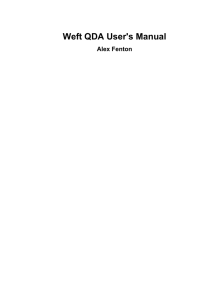Qualitative Data Analysis 1
advertisement
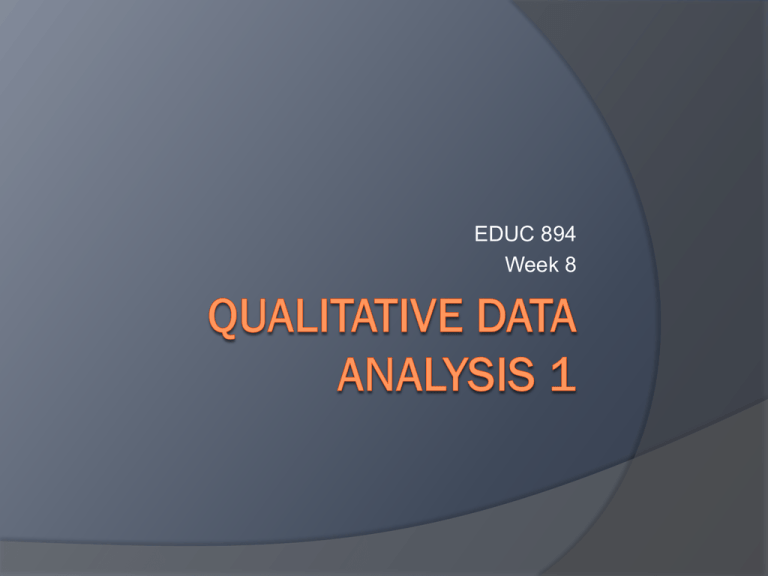
EDUC 894 Week 8 Plan for Today Conference Debrief What’s Hot in Analysis Methods: Engaging Complexity Group-work & Team Consultations Midterm Course Feedback Sheets --------------------Dinner Break------------------ Group-work & Team Consultations cont. Qualitative Data Analysis (7 pm) Overview of Approaches Class Activity: Analyzing Data Moving Forward Deliverable 3 Handout & Due Date Discussion Reading: Auerbach only (online book, pick up handout) Qualitative Data Can Be: Interviews Observation notes Images created by researchers or subjects Videos Student work But one thing is always true: Qualitative is voluminous (that’s a nice way of saying that it is easy to get overwhelmed) The Overriding Goal(s) Make inferences from the data to address your research questions Connect the empirical (specific data) with the theoretical (research inquiry) Most importantly it is a process of making meaning of the data This often involves looking for patterns This can occur simultaneously or in iteration with data collection And what does the data mean to whom…? Qualitative Data Analysis (QDA) Approaches: 2 Schools Back to the miner and the traveler What are they looking for & how will they go about it? Think about how their interview styles have set them up for the data analysis stage… QDA: The Miner Approach “Testing Theory” (Glaser) Does the data support our hypotheses? Does the data fit a preestablished framework? Closed Coding / Rating Interpretive Automatic Image Source: http://www.synthstuff.com/mt/archives/bertrand-miner.jpg QDA: The Miner Approach II Qualities of a Good Analysis Objective & Reliable ○ Multiple raters Inter-rater Reliability Number of decision points Tolerance & Reconciliation ○ Multiple measures Rubrics and consistency Valid ○ How do the indicators used serve as evidence of the ideas you are looking for? Examines all data in the sample Image Source: http://www.synthstuff.com/mt/archives/bertrand-miner.jpg QDA: The Miner Approach III Is this still really “qualitative” data analysis? Image Source: http://www.synthstuff.com/mt/archives/bertrand-miner.jpg QDA:The Traveler Approach “Generating Theory” (Glaser) What is the data trying to tell us? What are important themes related to the topic / phenomenon / RQs? What structure emerges from the data? Coding processes Range in structure and imposition of meaning Creswell presents a generic procedure Image Source: http://www.hmoon.com/garments/cloaks/traveler1-detail.jpg QDA:The Traveler Approach II Coding process decisions By question or overall ○ This highly relates to the kind of interview you conducted Target categories or completely open Number of coders; how and when to interact “Constant Comparison” Item to item Item to Category Category to Category Image Source: http://www.hmoon.com/garments/cloaks/traveler1-detail.jpg QDA:The Traveler Approach III So when are you done? Unlike the Miner – you aren't’ focused on “leaving no stone unturned,” but you will likely go over all the data several times. You will constantly be revising, combining and rethinking your codes - when no new themes are emerging, you may be nearing “theoretical saturation” Or you may need to go collect more data…. Image Source: http://www.hmoon.com/garments/cloaks/traveler1-detail.jpg Theorectical Saturation Data Collection Data Analysis Close to Saturated Categories Third Interview More Refined Categories Second Interview Refined Categories First Interview Preliminary Categories Toward Saturation of Categories QDA: The Traveler Approach IV Qualities of a Good Analysis Confirmability (Results are Investigator-free) ○ Triangulation ○ Search for Negative Evidence Dependability (Results are Stable) ○ Overlapping Methods ○ Cycles of Analysis and Data Collection Credibility (Results are Plausible) ○ Detailed analysis process ○ Coherence of results ○ Discussion of alternative explanations ○ Member Checks Image Source: http://www.hmoon.com/garments/cloaks/traveler1-detail.jpg QDA: Some Final Thoughts There is great variation in how QDA is done Your approach should be specific to your study (your RQ, your data and how it was collected) Since each instance is unique, it is very important to document your process The two approaches described here (generating theory and testing theory) can be combined (Glaser’s top left quadrant) You’ll read about another way of doing this in Auerbach Next week we’ll look at one technology to help manage masses of qualitative data (Atlas-ti) Class next week will be in Room 3100 Analyzing Data Activity Objectivist RQ: Are X,Y & Z important issues about vacations for graduate students? Constructionist RQ: How do graduate students think about vacations? Data source = X letters written by grad students about their vacations. Working in pairs, pick a stance and RQ and think about how you will analyze the data. In particular make sure to consider how the two of you will coordinate your efforts and how you will be able to justify either the validity & reliability (objectivist) or trustworthiness (constructionist) of your analysis.
